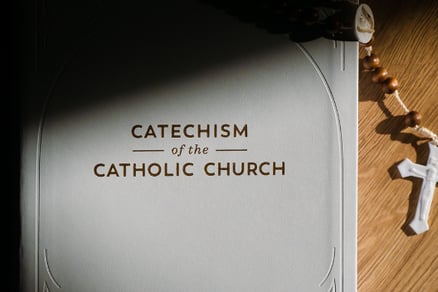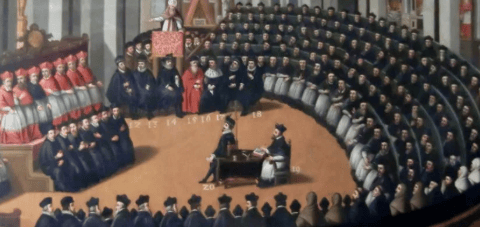Catechism of the Catholic Church (CCC)
"In the most blessed sacrament of the Eucharist, the body and blood, together with the soul and divinity, of our Lord Jesus Christ and, therefore, the whole Christ is truly, really, and substantially contained."
— CCC 1374
The mode of Christ’s presence under the Eucharistic species is unique. The Church uses the term “transubstantiation” to describe the change of the substance of bread and wine into the substance of Christ’s Body and Blood, while the appearances (or “accidents”) of bread and wine remain.
"By the consecration of the bread and wine there takes place a change of the whole substance... This change the holy Catholic Church has fittingly and properly called transubstantiation."
— CCC 1376







Catholic Teaching on the Real Presence
The Real Presence refers to the belief that Jesus Christ is truly, really, and substantially present—Body, Blood, Soul, and Divinity—in the Holy Eucharist.
This teaching is rooted in Jesus' own words at the Last Supper:
“This is my body, which will be given for you; do this in memory of me... This cup is the new covenant in my blood, which will be shed for you.”
— Luke 22:19-20
St. John Paul II wrote that in the Eucharist “we touch the mystery of Christ’s true presence and His sacrifice of love” (Ecclesia de Eucharistia, 11). He emphasized that our faith in the real presence must be “unwavering,” because from the Eucharist flows the strength of the Church and the hope of the world. The consecrated Host is not a piece of bread; it is Jesus Himself, veiled under the appearance of bread and wine. This reality invites us not only to receive Him with reverence but to remain with Him, to adore Him, and to let Him transform us in the silence of His presence.
Eucharistic Adoration is a natural response to belief in the Real Presence. Pope Benedict XVI reminded us that “adoration outside of Mass prolongs and intensifies all that takes place during the liturgical celebration itself” (Sacramentum Caritatis, 66). When we kneel before the Blessed Sacrament, we kneel before the Living God. It is there, in the quiet gaze of love, that Christ heals, speaks, and restores our brokenness. So many saints—from St. Thérèse of Lisieux to St. Teresa of Calcutta—found their strength in prolonged time before the Eucharist. The same transformation is available to us today.
Council of Trent (1545–1563)
In response to the Protestant Reformation, the Council of Trent solemnly reaffirmed:
"If anyone denies that in the sacrament of the most holy Eucharist are contained truly, really, and substantially the body and blood together with the soul and divinity of our Lord Jesus Christ, and consequently the whole Christ, but says that He is in it only as in a sign or figure or force, let him be anathema."
— Council of Trent, Session XIII, Canon 1


The Real Presence of Jesus in the Eucharist: A Call to Faith and Adoration
The Eucharist is the "source and summit of the Christian life" (Catechism of the Catholic Church, 1324). Within this sacrament, the entire mystery of our salvation is made present—Christ's passion, death, and resurrection are not merely remembered, but made real again in our midst. For Catholics, the Eucharist is not a symbol, but the actual Body and Blood, Soul and Divinity of Jesus Christ. This belief is rooted in the very words of Christ at the Last Supper: “This is my body... This is my blood” (Mark 14:22–24). The Church has always taken these words literally, as did the early Christians, who gathered not just to remember Jesus, but to receive Him.


Modern Catholics sometimes struggle with belief in the Real Presence, but this belief is a gift of faith, one that can be asked for and deepened through prayer. Jesus said in John 6:51, “I am the living bread that came down from heaven; whoever eats this bread will live forever.” The reaction of His listeners—many of whom walked away—shows that He was not speaking metaphorically. The Church Fathers, including St. Ignatius of Antioch in the first century, clearly affirmed this truth: “Take note of those who hold heterodox opinions… they do not confess that the Eucharist is the flesh of our Savior Jesus Christ” (Letter to the Smyrnaeans, 6:2–7:1).
Today, as in every generation, the Eucharist remains our treasure, our nourishment, and our hope. To believe in the Real Presence is to believe that God is not distant, but profoundly near—Emmanuel, “God with us.” In every tabernacle of the world, Jesus waits for us. He is not content to love us from afar. He comes to be with us, to be consumed by us, and to remain with us. May we, like the disciples at Emmaus, recognize Him in the breaking of the bread, and may our hearts burn within us as we adore Him in faith.





